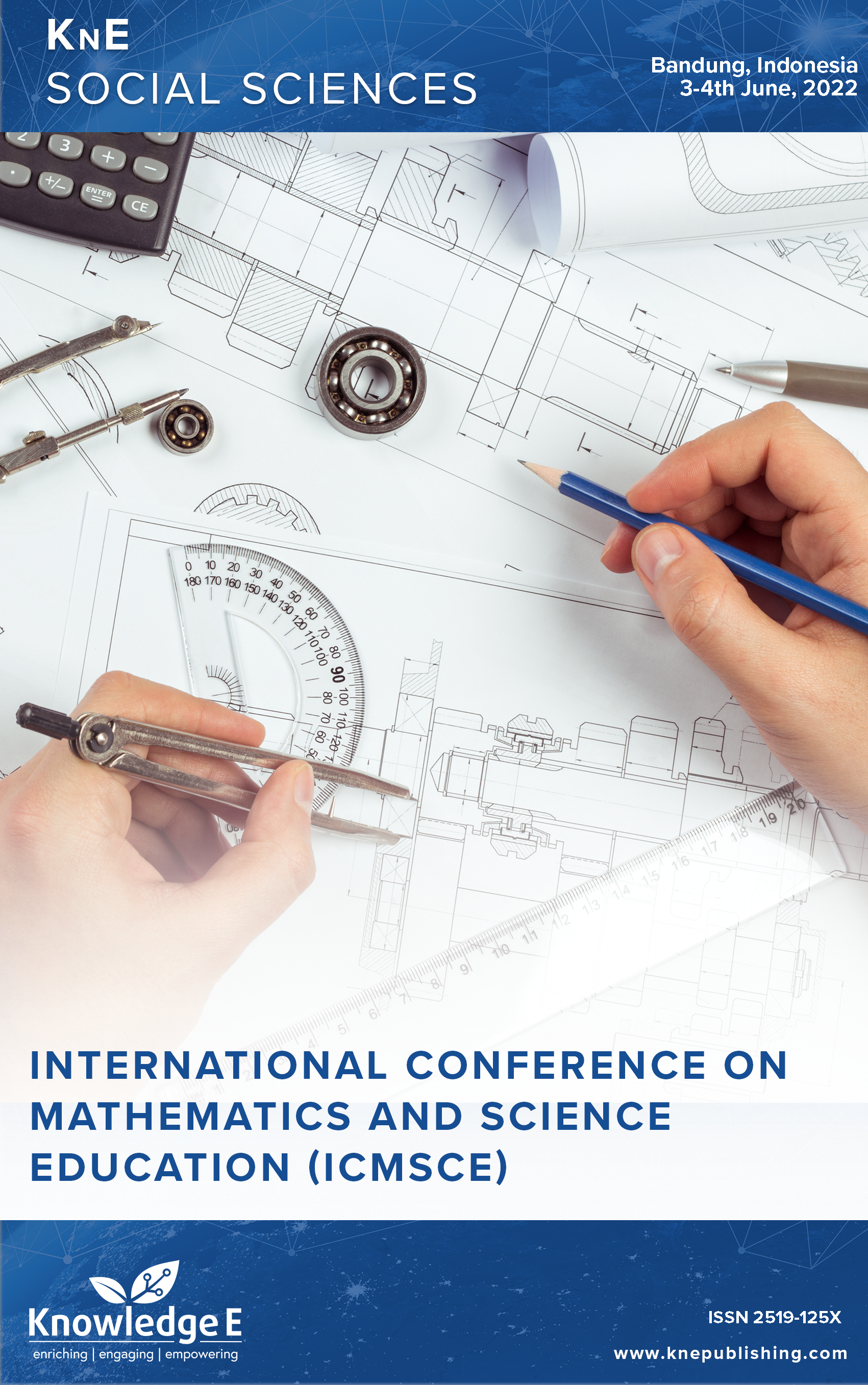Mathematical Communication Skills of Junior High School Students in Solving Straight Line Equation Problems Based on Learning Interest
DOI:
https://doi.org/10.18502/kss.v9i13.15922Abstract
One of the skills that students should possess to compete in the 21st century is communication skills, including mathematical communication skills. In short, mathematical communication skill is an ability of students to convey their mathematical ideas. However, the facts show that the mathematical communication skills of junior high school students are still relatively low. This problem is closely related to learning interests. This study aims to analyze and describe the mathematical communication skills of junior high school students in solving straight-line equation problems based on learning interest. This study used a qualitative research method with a case study design. The research subjects were 33 grade VIII students from one of the junior high schools in Bandung, West Java, Indonesia. Data were collected using triangulation techniques from data on mathematical communication skills tests about straight line equations, learning interest questionnaires, and interviews. The research findings revealed that students with good and very good learning interests, mostly at level 3 mathematical communication skills (in general they can communicate ideas effectively but there are some small errors), students in the good enough learning interest category are at level 2 mathematical communication skills (can communicate some ideas with slightly ambiguous explanations), and students in poor learning interest are at level 3 mathematical communication skills (in general they can communicate ideas effectively but there are some minor errors).
Keywords: mathematical communication,students, straight line equations, learning interest
References
Suryadi D, Herman T. “Eksplorasi matematika pembelajaran pemecahan masalah.,” Jakarta: Karya Duta Wahana. vol. 08, no. 2, p. 2008.
N.C.T.M. “Principles and standards for school mathematics.,” Presented at the (2000).
Cooke BD, Buchholz D. Mathematical communication in the classroom: A teacher makes a difference. Early Child Educ J. 2005;32(6):365–9. DOI: https://doi.org/10.1007/s10643-005-0007-5
Johar R, Junita E, Saminan S. Students’ mathematical communication ability and self-efficacy using team quiz learning model. International Journal on Emerging Mathematics Education. 2018;2(2):203. DOI: https://doi.org/10.12928/ijeme.v2i2.8702
Kosko KW, Wilkins JL. Mathematical communication and its relation to the frequency of manipulative use. International Electronic Journal of Mathematics Education. 2010;5(2):79–90. DOI: https://doi.org/10.29333/iejme/251
Rakhman PA, Suryadi D, Prabawanto S. Mathematical communication of junior high student based on the conceptual understanding of triangle. J Phys Conf Ser. 2019;1157(042115):042115. DOI: https://doi.org/10.1088/1742-6596/1157/4/042115
Selman YF, Jaedun A. Evaluation of the implementation of 4cskills in Indonesian subject at senior high schools. Jurnal Pendidikan Indonesia. 2020;9(2):244–57.
Rohid N, Suryaman S, Rusmawati RD. Students’ mathematical communication skills (MCS) in solving mathematics problems: A case in Indonesian context. Anatolian Journal of Education. 2019;4(2):19–30. DOI: https://doi.org/10.29333/aje.2019.423a
Saidah and D. Mardiani. Kesulitan siswa SMP terhadap soal komunikasi matematis pada materi penyajian data. Jurnal Pendidikan Matematika. 2021;1(4):531–40. DOI: https://doi.org/10.31980/plusminus.v1i3.960
Hibattulloh N, Sofyan D. Perbandingan kemampuan komunikasi matematis siswa antara yang menggunakan model pembelajaran kooperatif tipe jigsaw dengan konvensional. Jurnal Pendidikan Matematika. 2014;1(2):169–78. DOI: https://doi.org/10.31980/mosharafa.v3i3.321
Kadir, “Penerapan pembelajaran kontekstual berbasispotensi pesisir sebagai upaya peningkatan kemampuan pemecahan masalah matematik, komunikasi matematik, dan keterampilan sosial siswa SMP,” (2010).
Delyana H. Peningkatan kemampuan komunikasi matematis dan disposisi matematis siswa SMP melalui penerapan strategi the firing line dalam pembelajaran matematika. Jurnal Pendidikan Matematika. 2015;4(1):1–15. DOI: https://doi.org/10.31316/j.derivat.v4i2.151
J.Y. Tiara and Yuhasriati, “Kemampuan komunikasi matematis siswa melalui model pembelajaran kooperatif tipe jigsaw di SMA Negeri 1 Sinabang.,”. Jurnal Ilmiah Mahasiswa Pendidikan Matematika. 2020;5(1):40–6.
Pane NS, Jaya I, Lubis MS. “Analisis kemampuan komunikasi matematis siswa pada materi penyajian data di kelas VII MTs islamiyah Medan.,” Axiom : Jurnal Pendendidikan dan Matematika. vol. 7, no. 1, pp. 97–109, 2018. DOI: https://doi.org/10.30821/axiom.v7i1.1779
Slameto, Belajar dan faktor-faktor yang mempengaruhinya. Rineka Cipta, Jakarta, 2010.
Firdaus CB. Analisis faktor penyebab rendahnya minat belajar siswa terhadap mata pelajaran matematika di MTs ulul albab. J Educ. 2019;2(1):191–8. DOI: https://doi.org/10.31004/joe.v2i1.298
Sucipto MF, Firmansyah D. Analisis minat belajar siswa SMP pada pembelajaran matematika. Jurnal Pembembelajaran Matematika Inovatif. 2021;8(2):376–80.
M.R. Adnan, “Analisis kemampuan penalaran dan komunikasi siswa dalam menyelesaikan soal-soal aljabar kelas VII MTs Sultan Hasanuddin Kabupaten Gowa,” (2017).
Situmorang FG, Zulkardi Z. Kemampuan generalisasi pada materi persamaan garis lurus dalam pembelajaran PMRI di SMP Negeri 45 Palembang. Lentera Sriwijaya : Jurnal Ilmiah Pendidikan Matematika. 2019;1(1):64–76. DOI: https://doi.org/10.36706/jls.v1i1.9570
Sudijono A. Pengantar statistik pendidikan. PT. Depok: Rajagrafondo Persada; 2015.
Sugiyono, “Metode penelitian kualitatif,” (2020).
B.I. Ansari, “Komunikasi matematik strategi berfikir dan manajemen belajar konsep dan aplikasi,” (2018).
Robiah S, Rohaeti EE, Senjayawati E. Analisis kemampuan komunikasi matematis siswa berdasarkan minat belajar matematis siswa SMK Negeri 1 Cihampelas. J Educ. 2019;01(02):365–71.
L.S. Ningrum, “Analisis kemampuan siswa menyelesaikan soal matematika dalam bentuk cerita poko bahasan barisan dan deret pada siswa kelas XII SMA Al-Islam 3 Surakarta,” (2013).
N. Priatna, “Kemampuan penalaran dan pemahaman matematika siswa kelas 3 SLTP di Kota Bandung,” (2003).

